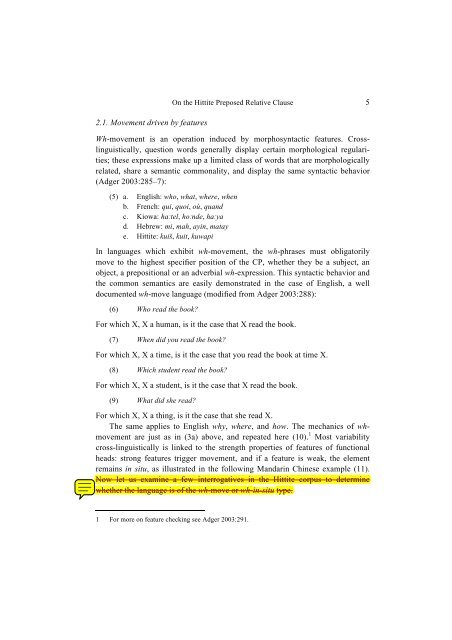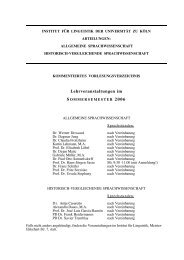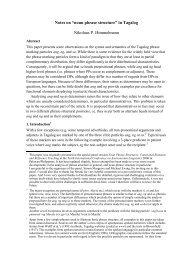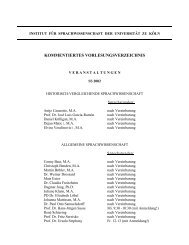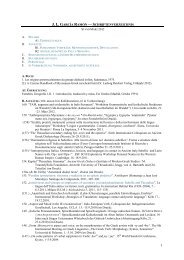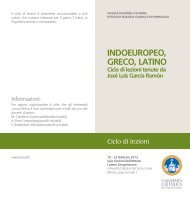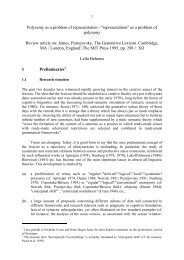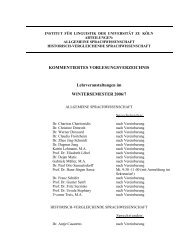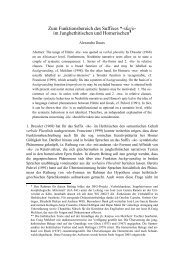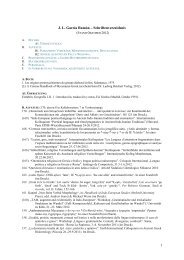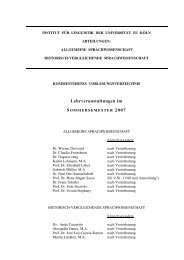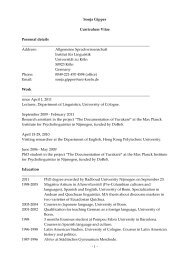Topics in Anatolian Historical Grammar Prof. Dr. H. Craig Melchert
Topics in Anatolian Historical Grammar Prof. Dr. H. Craig Melchert
Topics in Anatolian Historical Grammar Prof. Dr. H. Craig Melchert
Create successful ePaper yourself
Turn your PDF publications into a flip-book with our unique Google optimized e-Paper software.
2.1. Movement driven by features<br />
On the Hittite Preposed Relative Clause 5<br />
Wh-movement is an operation <strong>in</strong>duced by morphosyntactic features. Crossl<strong>in</strong>guistically,<br />
question words generally display certa<strong>in</strong> morphological regularities;<br />
these expressions make up a limited class of words that are morphologically<br />
related, share a semantic commonality, and display the same syntactic behavior<br />
(Adger 2003:285–7):<br />
(5) a. English: who, what, where, when<br />
b. French: qui, quoi, où, quand<br />
c. Kiowa: hatel, honde, haya<br />
d. Hebrew: mi, mah, ay<strong>in</strong>, matay<br />
e. Hittite: kui, kuit, kuwapi<br />
In languages which exhibit wh-movement, the wh-phrases must obligatorily<br />
move to the highest specifier position of the CP, whether they be a subject, an<br />
object, a prepositional or an adverbial wh-expression. This syntactic behavior and<br />
the common semantics are easily demonstrated <strong>in</strong> the case of English, a well<br />
documented wh-move language (modified from Adger 2003:288):<br />
(6) Who read the book?<br />
For which X, X a human, is it the case that X read the book.<br />
(7) When did you read the book?<br />
For which X, X a time, is it the case that you read the book at time X.<br />
(8) Which student read the book?<br />
For which X, X a student, is it the case that X read the book.<br />
(9) What did she read?<br />
For which X, X a th<strong>in</strong>g, is it the case that she read X.<br />
The same applies to English why, where, and how. The mechanics of whmovement<br />
are just as <strong>in</strong> (3a) above, and repeated here (10). 1 Most variability<br />
cross-l<strong>in</strong>guistically is l<strong>in</strong>ked to the strength properties of features of functional<br />
heads: strong features trigger movement, and if a feature is weak, the element<br />
rema<strong>in</strong>s <strong>in</strong> situ, as illustrated <strong>in</strong> the follow<strong>in</strong>g Mandar<strong>in</strong> Ch<strong>in</strong>ese example (11).<br />
Now let us exam<strong>in</strong>e a few <strong>in</strong>terrogatives <strong>in</strong> the Hittite corpus to determ<strong>in</strong>e<br />
whether the language is of the wh-move or wh-<strong>in</strong>-situ type.<br />
1 For more on feature check<strong>in</strong>g see Adger 2003:291.


